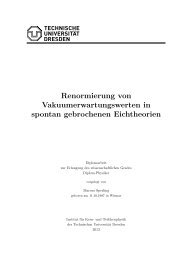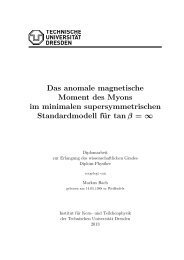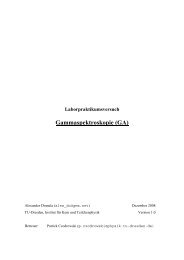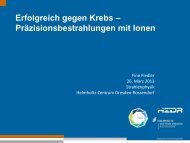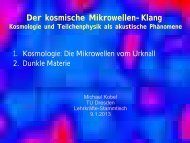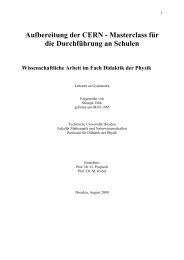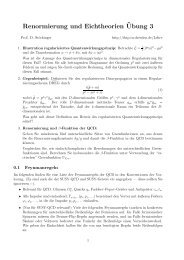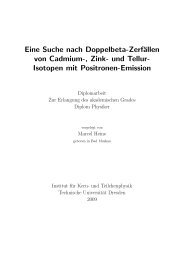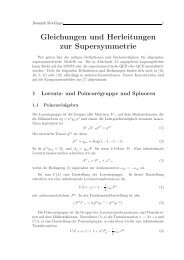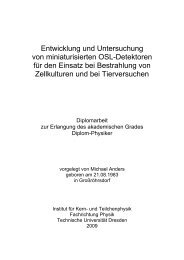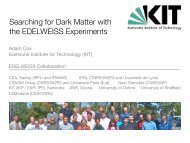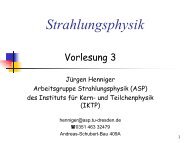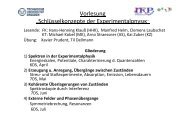a design study for a cobra upgrade to - Institut für Kern- und ...
a design study for a cobra upgrade to - Institut für Kern- und ...
a design study for a cobra upgrade to - Institut für Kern- und ...
Create successful ePaper yourself
Turn your PDF publications into a flip-book with our unique Google optimized e-Paper software.
12 3 The COBRA experiment<br />
CdZnTe (CZT) contains nine double beta decay iso<strong>to</strong>pes, which are<br />
listed in table 3.1 with their natural ab<strong>und</strong>ance, the possible decay<br />
mode and the Q-value.<br />
Iso<strong>to</strong>pe Q (keV) nat. ab. (%) decay mode<br />
64 Zn 1096 48.6 EC/EC, EC/β +<br />
70 Zn 1001 0.6 β − β −<br />
106 Cd 2771 1.3 EC/EC, EC/β + , β + β +<br />
108 Cd 231 0.9 EC/EC<br />
114 Cd 534 28.7 β − β −<br />
116 Cd 2805 7.5 β − β −<br />
120 Te 1722 0.1 EC/EC, EC/β +<br />
128 Te 868 31.7 β − β −<br />
130 Te 2529 33.8 β − β −<br />
Table 3.1: Double beta iso<strong>to</strong>pes of relevance <strong>for</strong> the COBRA experiment,<br />
with Q-value, natural ab<strong>und</strong>ance and possible decay mode given<br />
according <strong>to</strong> Kiel [8].<br />
The most promising iso<strong>to</strong>pes <strong>for</strong> the COBRA experiment are 116 Cd and<br />
130 Te. Their decays have a high Q-value, which is favourable <strong>for</strong> the<br />
expected event rate as it varies with Q 5 <strong>for</strong> 0νββ. Additionally, 116 Cd<br />
has, with 2805 keV, an endpoint energy well over the highest occurring<br />
natural gamma line at 2614 keV from the 232 Th decay chain [16]. The<br />
Q-value of 130 Te is between this line and its Comp<strong>to</strong>n edge. This leads<br />
<strong>to</strong> a reduced backgro<strong>und</strong> <strong>for</strong> their expected 0νβ − β − gro<strong>und</strong> state transitions.<br />
A natural high ab<strong>und</strong>ance of 130 Te provides also relatively high<br />
source mass, already without using iso<strong>to</strong>pically enriched material. CZT<br />
contains also 106 Cd, which is one of only 6 known β + β + decay iso<strong>to</strong>pes.<br />
CdZnTe crystals are intrinsic II-VI semiconduc<strong>to</strong>r crystals with a zinc<br />
blende structure. They are produced by the High Pressure Bridgman<br />
Method with low intrinsic contamination, but also with a limited detec<strong>to</strong>r<br />
size of a few cm 3 . This requires a modular <strong>design</strong> <strong>for</strong> reaching<br />
high source mass, <strong>for</strong> which the collaboration investigates the advantages<br />
of a coincidence analysis. Owing <strong>to</strong> a large band gap of 1.6 eV,<br />
CZT detec<strong>to</strong>rs can be operated at room temperature, which avoids extensive<br />
cooling.<br />
Currently, different CZT detec<strong>to</strong>r <strong>design</strong>s are <strong>und</strong>er investigation.<br />
These are coplanar grid CZT detec<strong>to</strong>rs, which will be discussed further<br />
on and two different pixelated <strong>design</strong>s, which show promising possibilities<br />
of a very effective backgro<strong>und</strong> reduction. For the recent activities



